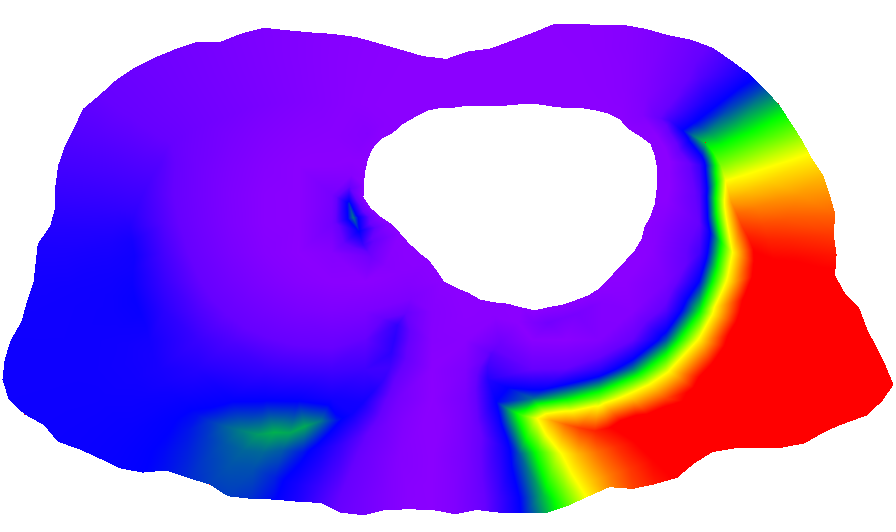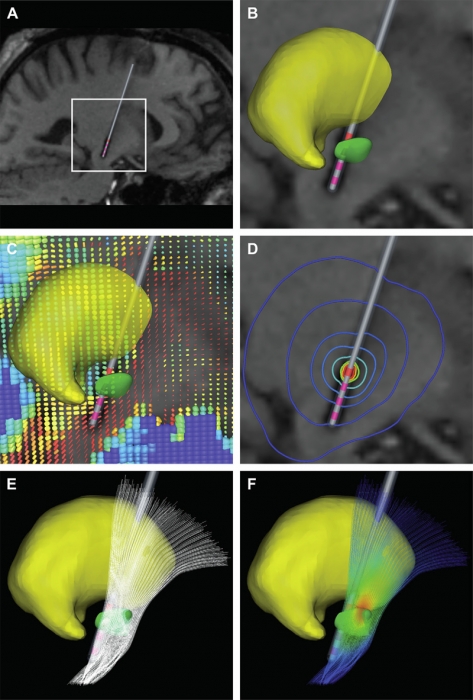SCI Publications
2011


S. Williams, M. Petersen, P.-T. Bremer, M. Hecht, V. Pascucci, J. Ahrens, M. Hlawitschka, B. Hamann.
“Adaptive Extraction and Quantification of Geophysical Vortices,” In IEEE Transactions on Visualization and Computer Graphics, Proceedings of the 2011 IEEE Visualization Conference, Vol. 17, No. 12, pp. 2088--2095. 2011.


C. Yang, D. Xiu, R.M. Kirby.
“Visualization of Covariance and Cross-covariance Field,” In International Journal for Uncertainty Quantification, Vol. 3, No. 1, pp. 25--38. 2011.
DOI: 10.1615/Int.J.UncertaintyQuantification.2011003369
We present a numerical technique to visualize covariance and cross-covariance fields of a stochastic simulation. The method is local in the sense that it demonstrates the covariance structure of the solution at a point with its neighboring locations. When coupled with an efficient stochastic simulation solver, our framework allows one to effectively concurrently visualize both the mean and (cross-)covariance information for two-dimensional (spatial) simulation results. Most importantly, the visualization provides the scientist a means to identify interesting correlation structure of the solution field. The mathematical setup is discussed, along with several examples to demonstrate the efficacy of this approach.
Keywords: netl


H. Zhu, L. Kong, R. Li, M.S. Styner, G. Gerig, W. Lin, J.H. Gilmore.
“FADTTS: Functional Analysis of Diffusion Tensor Tract Statistics,” In NeuroImage, Vol. 56, No. 3, pp. 1412--1425. 2011.
DOI: 10.1016/j.neuroimage.2011.01.075
PubMed ID: 21335092
2010


G. Adluru, T. Tasdizen, M.C. Schabel, E.V.R. DiBella.
“Reconstruction of 3D Dynamic Contrast-Enhanced Magnetic Resonance Imaging Using Nonlocal Means,” In Journal of Magnetic Resonance Imaging, Vol. 32, pp. 1217--1227. 2010.
DOI: 10.1002/jmri.22358


G. Adluru, T. Tasdizen, R. Whitaker, E. DiBella.
“Improving Undersampled MRI Reconstruction Using Non-Local Means,” In Proceedings of the 2010 International Conference on Pattern Recognition, pp. 4000--4003. 2010.
DOI: 10.1109/ICPR.2010.973


A.E. Anderson, B.J. Ellis, S.A. Maas, J.A. Weiss.
“Effects of idealized joint geometry on finite element predictions of cartilage contact stresses in the hip,” In Journal of Biomechanics, Vol. 43, No. 7, pp. 1351--1357. May, 2010.
Computational models may have the ability to quantify the relationship between hip morphology, cartilage mechanics and osteoarthritis. Most models have assumed the hip joint to be a perfect ball and socket joint and have neglected deformation at the bone-cartilage interface. The objective of this study was to analyze finite element (FE) models of hip cartilage mechanics with varying degrees of simplified geometry and a model with a rigid bone material assumption to elucidate the effects on predictions of cartilage stress. A previously validated subject-specific FE model of a cadaveric hip joint was used as the basis for the models. Geometry for the bone-cartilage interface was either: (1) subject-specific (i.e. irregular), (2) spherical, or (3) a rotational conchoid. Cartilage was assigned either a varying (irregular) or constant thickness (smoothed). Loading conditions simulated walking, stair-climbing and descending stairs. FE predictions of contact stress for the simplified models were compared with predictions from the subject-specific model. Both spheres and conchoids provided a good approximation of native hip joint geometry (average fitting error ∼0.5 mm). However, models with spherical/conchoid bone geometry and smoothed articulating cartilage surfaces grossly underestimated peak and average contact pressures (50% and 25% lower, respectively) and overestimated contact area when compared to the subject-specific FE model. Models incorporating subject-specific bone geometry with smoothed articulating cartilage also underestimated pressures and predicted evenly distributed patterns of contact. The model with rigid bones predicted much higher pressures than the subject-specific model with deformable bones. The results demonstrate that simplifications to the geometry of the bone-cartilage interface, cartilage surface and bone material properties can have a dramatic effect on the predicted magnitude and distribution of cartilage contact pressures in the hip joint.
Keywords: mrl


E.W. Anderson, G.A. Preston, C.T. Silva.
“Using Python for Signal Processing and Visualization,” In IEEE Computing in Science and Engineering, Vol. 12, No. 4, pp. 90--95. 2010.


J.R. Anderson, B.C. Grimm, S. Mohammed, B.W. Jones, T. Tasdizen, J. Spaltenstein, P. Koshevoy, R.T. Whitaker, R.E. Marc.
“The Viking Viewer: Scalable Multiuser Annotation and Summarization of Large Volume Datasets,” In Journal of Microscopy, Vol. 241, No. 1, pp. 13--28. 2010.
DOI: 10.1111/j.1365-2818.2010.03402.x


G.A. Ateshian, S.A. Maas, J.A. Weiss.
“Finite element algorithm for frictionless contact of porous permeable media under finite deformation and sliding,” In Journal of Biomechanical Engineering, Vol. 132, No. 6, Note: Cover article, 2010.


S.P. Awate, P.A. Yushkevich, Z. Song, D.J. Licht, J.C. Gee.
“Cerebral cortical folding analysis with multivariate modeling and testing: Studies on gender differences and neonatal development,” In NeuroImage, Vol. 53, No. 2, pp. 450--459. 2010.
PubMed ID: 20630489


T.J. Badger, M. Daccarett, N.W. Akoum, Y.A. Adjei-Poku, N.S. Burgon, T.S. Haslam, S. Kalvaitis, S. Kuppahally, G. Vergara, L. McMullen, P.A. Anderson, E. Kholmovski, R.S. Macleod, N.F. Marrouche.
“Evaluation of left atrial lesions after initial and repeat atrial fibrillation ablation: lessons learned from delayed-enhancement MRI in repeat ablation procedures,” In Circulation. Arrhythmia and Electrophysiology, Vol. 3, No. 3, pp. 249--259. 2010.
PubMed ID: 20335558


M. Berger, L.G. Nonato, V. Pascucci, C.T. Silva.
“Fiedler Trees for Multiscale Surface Analysis,” In Computer & Graphics, Vol. 34, No. 3, Note: Special Issue of Sha, pp. 272--281. June, 2010.
DOI: 10.1016/j.cag.2010.03.009
In this work we introduce a new hierarchical surface decomposition method for multiscale analysis of surface meshes. In contrast to other multiresolution methods, our approach relies on spectral properties of the surface to build a binary hierarchical decomposition. Namely, we utilize the first nontrivial eigenfunction of the Laplace–Beltrami operator to recursively decompose the surface. For this reason we coin our surface decomposition the Fiedler tree. Using the Fiedler tree ensures a number of attractive properties, including: mesh-independent decomposition, well-formed and nearly equi-areal surface patches, and noise robustness. We show how the evenly distributed patches can be exploited for generating multiresolution high quality uniform meshes. Additionally, our decomposition permits a natural means for carrying out wavelet methods, resulting in an intuitive method for producing feature-sensitive meshes at multiple scales.


M. Berzins, J. Luitjens, Q. Meng, T. Harman, C.A. Wight, J.R. Peterson.
“Uintah: A Scalable Framework for Hazard Analysis,” In Proceedings of the Teragrid 2010 Conference, TG 10, Note: Awarded Best Paper in the Science Track!, pp. (published online). July, 2010.
ISBN: 978-1-60558-818-6
DOI: 10.1145/1838574.1838577
The Uintah Software system was developed to provide an environment for solving a fluid-structure interaction problems on structured adaptive grids on large-scale, long-running, data-intensive problems. Uintah uses a novel asynchronous task-based approach with fully automated load balancing. The application of Uintah to a petascale problem in hazard analysis arising from "sympathetic" explosions in which the collective interactions of a large ensemble of explosives results in dramatically increased explosion violence, is considered. The advances in scalability and combustion modeling needed to begin to solve this problem are discussed and illustrated by prototypical computational results.
Keywords: Uintah, csafe


M. Berzins.
“Nonlinear Data-Bounded Polynomial Approximations and their Applications in ENO Methods,” In Numerical Algorithms, Vol. 55, No. 2, pp. 171. 2010.


J.J.E. Blauer, J. Cates, C.J. McGann, E.G. Kholmovski, A. Alexander, M.W. Prastawa, S. Joshi, N.F. Marrouche, R.S. MacLeod.
“MRI Based Injury Characterization Immediately Following Ablation of Atrial Fibrillation,” In Computing in Cardiology, Vol. 37, pp. 165--168. 2010.
ISSN: 0276−6574


C. Brownlee, V. Pegoraro, S. Shankar, P. McCormick, C.D. Hansen.
“Physically-Based Interactive Schlieren Flow Visualization,” In Proceedings of IEEE Pacific Visualization 2010, Note: Won Best Paper Award!, 2010.


J.R. Bronson, J.A. Levine, R.T. Whitaker.
“Particle Systems for Adaptive, Isotropic Meshing of CAD Models,” In Proceedings of the 19th International Meshing Roundtable, Note: Awarded Best Paper, Springer, pp. 279-296. 2010.
DOI: 10.1007/978-3-642-15414-0_17
We present a particle-based approach for generating adaptive triangular surface and tetrahedral volume meshes from CAD models. Input shapes are treated as a collection of smooth, parametric surface patches that can meet non-smoothly on boundaries. Our approach uses a hierarchical sampling scheme that places particles on features in order of increasing dimensionality. These particles reach a good distribution by minimizing an energy computed in 3D world space, with movements occurring in the parametric space of each surface patch.
Rather than using a pre-computed measure of feature size, our system automatically adapts to both curvature as well as a notion of topological separation. It also enforces a measure of smoothness on these constraints to construct a sizing field that acts as a proxy to piecewise-smooth feature size. We evaluate our technique with comparisons against other popular triangular meshing techniques for this domain.


A. Chaturvedi, C.R. Butson, S.F. Lempka, S.E. Cooper, C.C. McIntyre.
“Patient-specific models of deep brain stimulation: influence of field model complexity on neural activation predictions,” In Brain Stimulation, Vol. 3, No. 2, Elsevier Inc., pp. 65--67. April, 2010.
ISSN: 1935-861X
DOI: 10.1016/j.brs.2010.01.003
PubMed ID: 20607090
Deep brain stimulation (DBS) of the subthalamic nucleus (STN) has become the surgical therapy of choice for medically intractable Parkinson's disease. However, quantitative understanding of the interaction between the electric field generated by DBS and the underlying neural tissue is limited. Recently, computational models of varying levels of complexity have been used to study the neural response to DBS. The goal of this study was to evaluate the quantitative impact of incrementally incorporating increasing levels of complexity into computer models of STN DBS. Our analysis focused on the direct activation of experimentally measureable fiber pathways within the internal capsule (IC). Our model system was customized to an STN DBS patient and stimulation thresholds for activation of IC axons were calculated with electric field models that ranged from an electrostatic, homogenous, isotropic model to one that explicitly incorporated the voltage-drop and capacitance of the electrode-electrolyte interface, tissue encapsulation of the electrode, and diffusion-tensor based 3D tissue anisotropy and inhomogeneity. The model predictions were compared to experimental IC activation defined from electromyographic (EMG) recordings from eight different muscle groups in the contralateral arm and leg of the STN DBS patient. Coupled evaluation of the model and experimental data showed that the most realistic predictions of axonal thresholds were achieved with the most detailed model. Furthermore, the more simplistic neurostimulation models substantially overestimated the spatial extent of neural activation.
Keywords: Action Potentials, Action Potentials: physiology, Computer Simulation, Deep Brain Stimulation, Deep Brain Stimulation: instrumentation, Deep Brain Stimulation: methods, Humans, Male, Middle Aged, Models, Neurological, Parkinson Disease, Parkinson Disease: therapy, Subthalamic Nucleus, Subthalamic Nucleus: physiology


A.N.M. Imroz Choudhury, M.D. Steffen, J.E. Guilkey, S.G. Parker.
“Enhanced Understanding of Particle Simulations Through Deformation-Based Visualization,” In Computer Modeling in Engineering & Sciences, Vol. 63, No. 2, pp. 117--136. 2010.


J. Cui, P. Rosen, V. Popescu, C. Hoffmann.
“A Curved Ray Camera for Handling Occlusions through Continuous Multiperspective Visualization,” In IEEE Transactions on Visualization and Computer Graphics (Visualization 2010), pp. 1235--1242. November/December, 2010.






